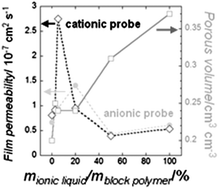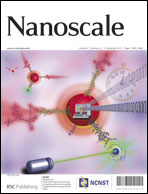Bimodal mesoporous titanium dioxide anatase films templated by a block polymer and an ionic liquid: influence of the porosity on the permeability†
Abstract
In the present paper, we report the synthesis of bimodal mesoporous anatase TiO2 films by the EISA (Evaporation-Induced Self-Assembly) method using sol–gel chemistry combining two porogen agents, a low molecular weight ionic template and a neutral block copolymer. The surfactant template (C16mimCl) generates non-oriented worm-like pores (8 to 10 nm) which connect the regularly packed ellipsoidal mesopores (15 to 20 nm diameter) formed by an amphiphilic block copolymer of the type poly(isobutylene)-b-poly(ethylene oxide) (PIB–PEO). The surfactant template can also significantly influence the size and packing of the ellipsoidal mesopores. The mesostructural organization and mesoporosity of the films are studied by Environmental Ellipsometry-Porosimetry (EEP), Grazing-Incidence Small-Angle X-ray Scattering (GISAXS) and electron microscopy techniques. Electrochemical characterization is performed to study the permeability of the films to liquid solutions, using two types of probe moieties (K3FeIII(CN)6 and Ru(bpy)32+) by the wall-jet technique. An optimum ratio of C16mimCl/PIB–PEO provides anatase films with a continuous bimodal mesopore structure, possessing a permeability up to two times higher than that of the mesoporous films templated by PIB–PEO only (with partially isolated mesopores). When C16mimCl is used in large quantities, up to 20% weight vs. PIB–PEO, large overall porous volume and surface area are obtained, but the mesostructure is increasingly disrupted, leading to a severe loss of permeability of the bimodal films. A dye-sensitized solar cell set-up is used with anatase films as the photoelectrode. The photosensitizer loading and the total energy conversion efficiency of the solar cells using the mesoporous films templated by an optimal ratio of the two porogen agents C16mimCl and PIB–PEO can be substantially increased in comparison with the solar cells using mesoporous films templated by PIB–PEO only.


 Please wait while we load your content...
Please wait while we load your content...